LAFF Home January February March April May June July August September October November December Fungal Groups Habitats
Non-lichenised Ascomycota
| Species (links to species information) | Associated organisms/substrata | When to look | Localities | Last recorded (pre project) | Successful search (during project lifespan) | British sites | ||||
| Pre-1965 | 1965-June 2014 | July 2014-present (LAFF) | Extant (since 1965) | |||||||
 |
Amanita nivalis
PDF - Species Datasheet |
Ectomycorrhizal with Salix herbacea in montane dwarf shrub communities | Jun-Oct | Fairly widespread but infrequently recorded from the Grampians and North-West Highlands of Scotland, the Lake District in Cumbria, and Snowdonia in Caernarvonshire. | 2013 | Yes | 4 | 23 | 9 | 27 |
 |
Anthostomella alchemillae | Known from dead leaves of Alchemilla alpina | May-Sept | A Scottish endemic based on current records, fairly widely distributed in western montane sites where the host occurs but not recorded frequently in recent times. | 1986 | Yes | 6 | 3 | 2 | 5 |
 |
Biscogniauxia marginata | In GB&I, on dead Malus bark. Known elsewhere from various hardwood species, mostly belonging to the Rosaceae | Jan-Dec? | England (NE Yorkshire). | 1910 | 1 | 0 | 0 | 0 | |
 |
Cryptomyces maximus | A weak parasite of Salix branches, sometimes associated with mechanical damage | Feb-Dec, probably Jan-Dec. | Recent records from Wales (Pembrokeshire), with a single new locality in Shropshire. | 2013 | Yes | 5 | 7 | 22 | 24 |
 |
Daldinia petriniae | A Daldinia concentrica look-alike found on Alnus (alder). | Jan-Dec | Single sites recorded in North Hampshire, Surrey, Worcester, and Warwickshire. | 1998 | Yes | 1 | 2 | 1 | 3 |
 |
Encoelia carpini
PDF - Species Datasheet |
A fairly conspicuous brown discomycete on dead attached and fallen branches of Carpinus betulus (hornbeam). | Jul-Oct | Confirmed records from Surrey and Hertfordshire, possibly also from Kent. | 2004 | Yes | 0 | 1 | 1 | 2 |
 |
Geoglossum uliginosum | An earthtongue from boggy areas, often associated with Sphagnum. | Sept-Oct | Scattered throughout England, Northern Ireland, Scotland and Wales. | 2007 | Yes | 0 | 3 | 1 | 4 |
 |
Hygrocybe marchii sensu Boertman edn. 1 | A Hygrocybe coccinea lookalike with smaller constricted spores, found in grasslands. | Aug-Nov | Distribution undergoing reassessment due to past confusion regarding species concepts under this name. Most records of "marchii" in other databases may be H. reidii or other taxa. | 2013 | 0 | 6 | 0 | 6 | |
 |
PDF - Species Datasheet |
Parasitic on Hymenochaetopsis tabacina (=Hymenochaete tabacina), usually found associated with Salix spp. | Jan-Dec | The only confirmed recent records are from Wales (Radnorshire), and now also from Scotland (Berwickshire). | 1993 | Yes | 6 | 1 | 3 | 3 |
 |
Hypoxylon fuscoides | A Hypoxylon fuscum (hazel woodwart) lookalike, on Alnus or Betula spp. | Jan-Dec? | Known from Ireland (County Down and County Armagh), England (Derbyshire and Buckinghamshire), and Wales (Glamorgan). | 2011 | Yes | 0 | 2 | 6 | 8 |
 |
Microglossum atropurpureum | A purple-brown to purple-black earthtongue with colourless spores, found in unimproved grassland. | Aug-Feb | Widely distributed but infrequently recorded in England, Wales, Scotland and Ireland. | 2013 | Yes | 24 | 62 | 2 | 63 |
 |
Mollisia subglobosa | On felled trunks of Ilex aquifolium, in association with Nectria punicea var. ilicis. | Dec-Feb | England (historical records from S Hampshire, now also reported from Somerset and Wales (Pembrokeshire). | 2013 | Yes | 0 | 4 | 2 | 6 |
 |
Phaeosphaeria silenes-acaulis | A minute perithecial species found on dead leaves and bracts of Silene acaulis. | May-Oct | Reported from Scotland (Mull and Rhum); recently found also in Shetland and Snowdonia. | 1974 | Yes | 2 | 1 | 2 | 3 |
 |
PDF - Species Datasheet |
A parasitic ascomycete with bright red stromata on living leaves of blackthorn, cultivated plum and hybrids. | May-Oct | At one time widely distributed, but now much more restricted in location. Largely confined to the west coast of Ireland, SW England and west Wales, but also now known from SW Scotland. | 2010 | Yes | 38 | 7 | 20 | 25 |
|
|
Poronia erici | A fungus with a 3-8 mm diam. nail- or golf-tee like fruitbody growing in rabbit or pony dung; a Poronia punctata lookalike but smaller with larger spores. | Mar-Nov? | Known only from two sites in West Norfolk and one in East Suffolk. Possibly overlooked and more widely distributed, especially if mistaken for P. punctata. | 2011 | Yes | 1 | 2 | 1 | 2 |
 |
Rutstroemia johnstonii (=Dencoeliopsis johnstonii) | Apparently restricted to stromata of Xenotypa aterrima, itself a rarely encountered species on recently dead branches of Betula. | Jun-Oct | Recent records from England (Surrey) and N Ireland (Londonderry); now also reported from Scotland (Berwickshire). | 2006 | Yes | 1 | 1 | 2 | 3 |
 |
PDF - Species Datasheet |
In GB&I, on dead (burnt) wood of Ulex europaeus (gorse). Elsewhere on wood and bark of various legumes. | Jan-Dec? | England (S Hampshire); first found in 2014, re-found on the same site in 2015, and at three further locations in the New Forest. | 2014 | Yes | 0 | 0 | 4 | 4 |
 |
Xylaria crozonensis | Probably a saprobe; known from bark of Betula, Corylus and Quercus. | Mar-Nov | England (VC2 East Cornwall, and VC1 West Cornwall). | 2013 | Yes | 0 | 3 | 20 | 22 |
Larger Basidiomycota
| Species (links to species information) | Associated organisms/substrata | When to look | Localities | Last recorded (pre project) | Successful search (during project lifespan) | British sites | Maps | ||||
| Pre-1965 | 1965-June 2014 | July 2014-present (LAFF) | Extant (since 1965) | ||||||||
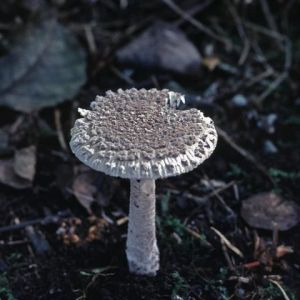 |
Amanita friabilis | In damp woodland soil associated with Alnus. | Sept | In Britain and Ireland, verified and DNA-sequenced voucher specimens are known only from one site in Cumbria (England) and one in Antrim (Ireland). Many other voucher specimens at Kew have been redetermined. | 2013 | 0 | 1 | 0 | 1 | Map | |
 |
Amanita nivalis
PDF - Species Datasheet |
Ectomycorrhizal with Salix herbacea in montane dwarf shrub communities | Jun-Oct | Fairly widespread but infrequently recorded from the Grampians and North-West Highlands of Scotland, the Lake District in Cumbria, and Snowdonia in Caernarvonshire. | 2013 | Yes | 4 | 23 | 9 | 27 | Map |
 |
Amanita ovoidea | Under Quercus ilex, and in calcareous grassland with Helianthemum. | Jul-Oct | Wiltshire and Isle of Wight. | 2010 | Yes | 0 | 2 | 1 | 2 | Map |
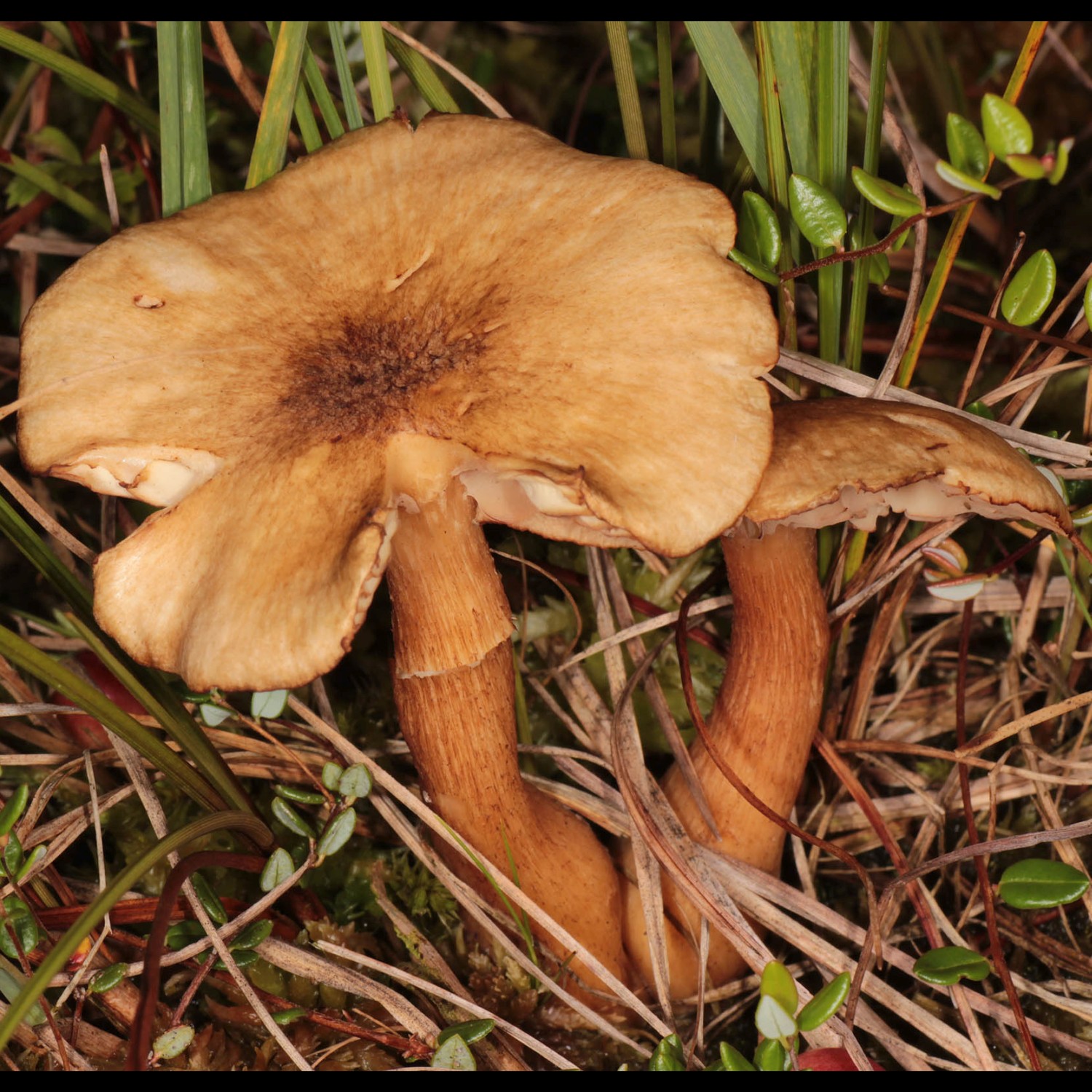 |
Armillaria ectypa | In marshes, upland bogs and reed beds. | Jul-Oct | Scattered throughout Great Britain and Northern Ireland. | 2009 | Yes | 0 | 8 | 6 | 12 | Map |
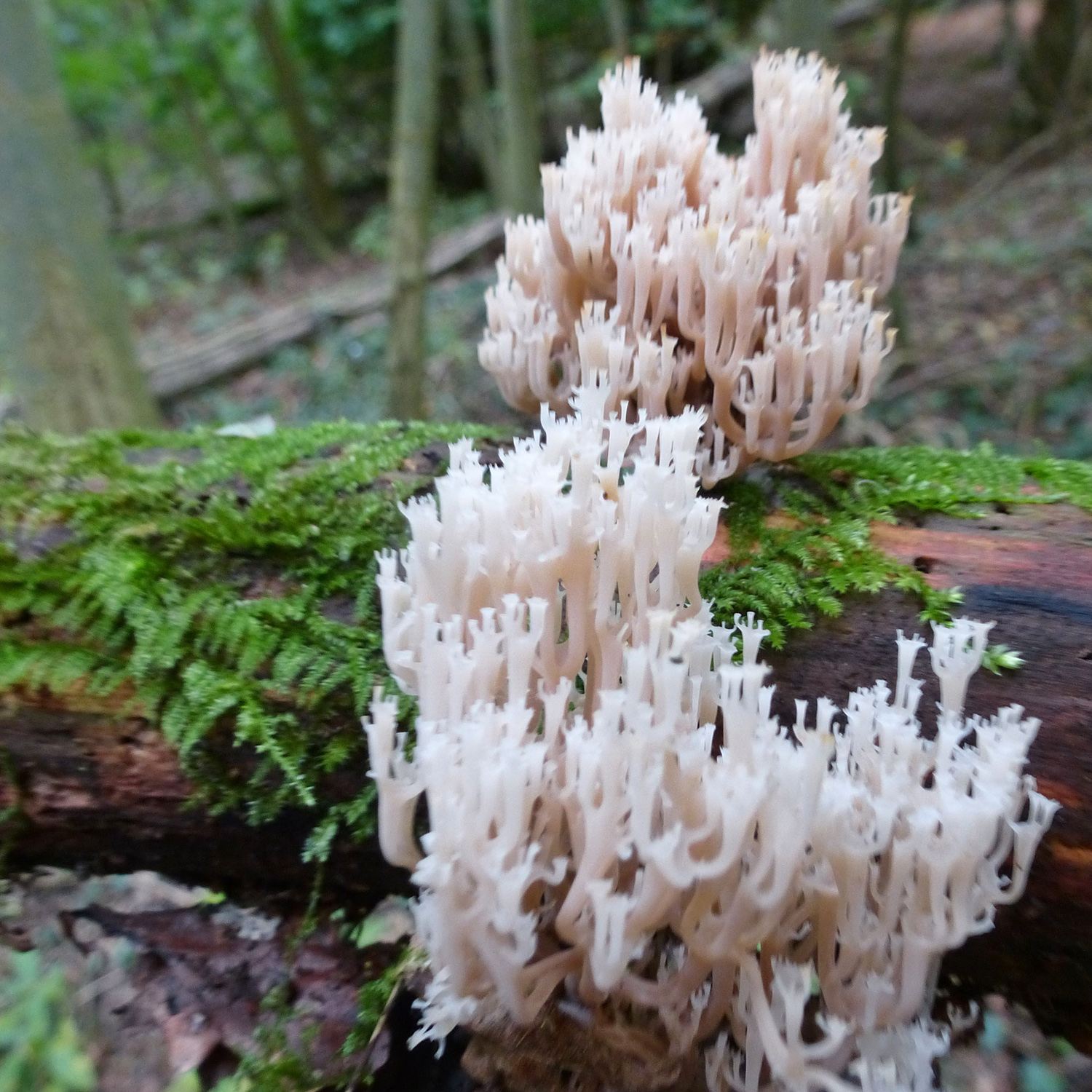 |
Artomyces pyxidatus | An elegantly whorled white to yellow to brown coral fungus with distinctive crown-like branch tips, found on rotten wood. | Oct | Known only from a single record in Worcestershire in 1896, and a recent rediscovery in East Suffolk in 2012. | 2012 | 1 | 1 | 0 | 1 | Map | |
 |
Battarrea phalloides | A distinctive fungus comprising a woody stalk supporting a rust-coloured powdery spore mass. Found in dry places, often in sandy soil on hedge banks and roadsides, often associated with ash (Fraxinus), Hawthorn (Crataegus) or elm (Ulmus). | Jan-Dec | Widely but sparsely distributed throughout the south of England, with strongholds in Norfolk and Suffolk. | 2014 | Yes | 17 | 36 | 11 | 46 | Map |
| Boletus fechtneri | A boletoid fungus found on lime rich soil with Beech (Fagus) Oak (Quercus) and sweet chestnut (Castanea sativa). | Jul-Oct | Recorded from scattered sites mainly in Southern England. Confirmed from a single site in Herefordshire. | 2010 | 0 | 16 | 0 | 16 | Map | ||
 |
PDF - Species Datasheet |
A small white puffball associated with mosses in calcareous fen habitats | May-Oct | Recent sites in England (Norfolk, Yorkshire and Westmorland), Wales (Breconshire), and Scotland (Roxburghshire). | 2005 | Yes | 3 | 3 | 2 | 5 | Map |
 |
Bovista pusilla | A very tiny puffball of 0.5-1.5 mm diameter, found on grey dune slacks. Previously known in Britain as B. limosa. | Aug-Nov | Known from England (South Lancashire, Westmorland); Wales (Pembrokeshire, Carmarthenshire and Glamorgan); and Scotland (Kincardineshire). Historically recorded in West Norfolk. | 2014 | Yes | 1 | 11 | 4 | 14 | Map |
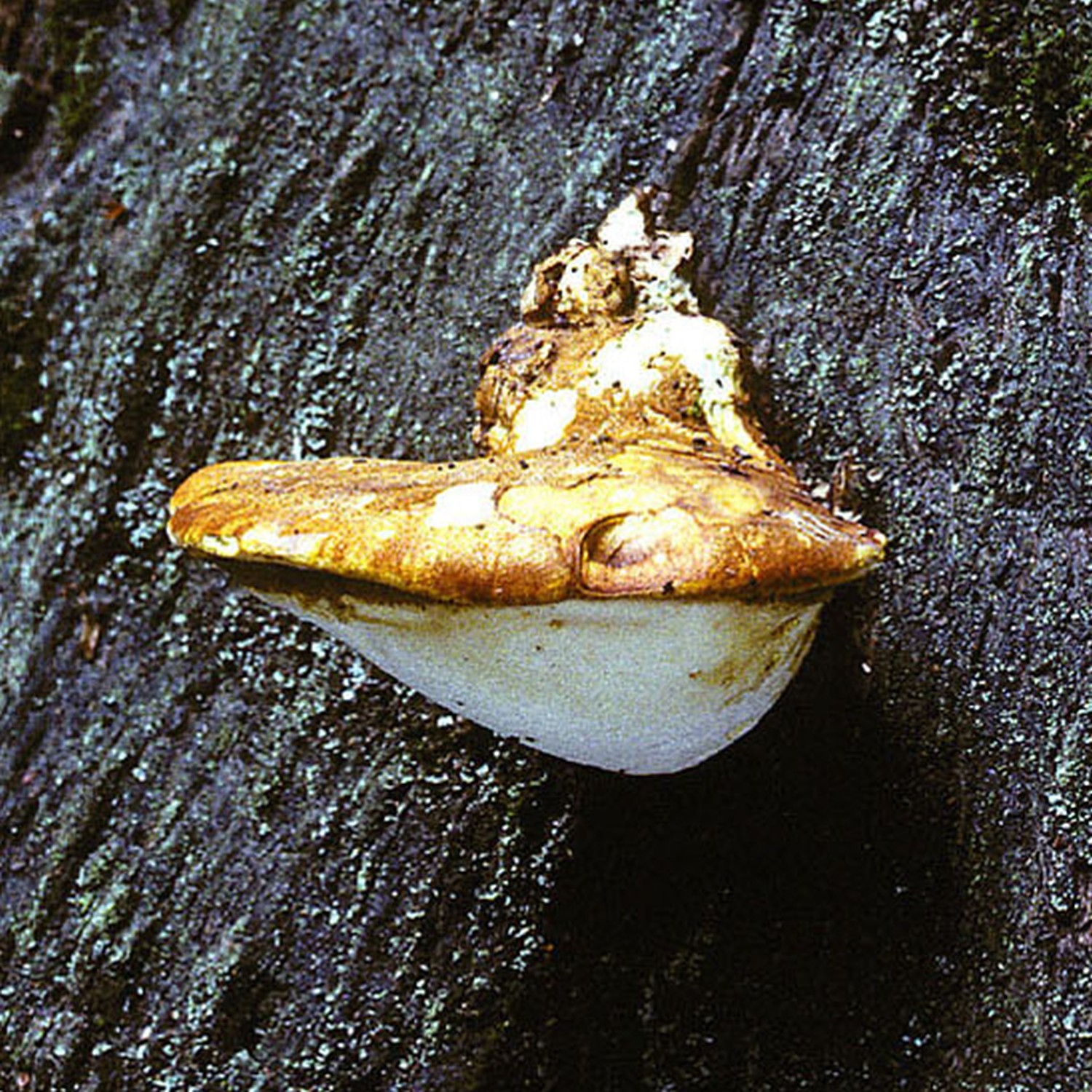 |
Buglossoporus quercinus | A bracket fungus found on the exposed heartwood of old oak trees (Quercus) often in ancient deer parks and forest pastures. | Jun-Oct (also Jan and Feb) | Scattered throughout England and Wales, more frequent in the South East, with a single site in Scotland. | 2014 | Yes | 11 | 65 | 13 | 67 | Map |
 |
Chromosera citrinopallida | A yellow waxcap from upland dwarf-shrub heaths, deep moss, unimproved grassland, drier areas of bogs and snow beds. | Sept-Jan | Known from Scotland (S Aberdeenshire, E Ross), Northern Ireland (Antrim). Records revised with those from grassland sites in England (Mid-west Yorkshire, S Lancashire, Herefordshire) and Wales (Radnor) considered misidentifications. | 2008 | 0 | 3 | 0 | 3 | Map | |
 |
Chromosera lilacina | A lilac to brownish orange waxcap from wet upland dwarf-shrub heaths, marshes and snow beds. | Sept-Nov | Recorded from the Cairngorms, Western Highlands and Mull in Scotland and Cheshire in England. | 2010 | Yes | 4 | 11 | 2 | 13 | Map |
 |
Dichomitus efibulatus (= Polyporus efibulatus) | A poroid fungus causing a white rot on the dead attached wood or woody stems of blackthorn (Prunus), hazel (Corylus), gorse (Ulex) rose (Rosa) blackberry (Rubus) and hornbeam (Carpinus). | Jan-Dec | Most records are from South West England (Cornwall & Devon) it has also been found in S. Hampshire, the Isle of Wight and Guernsey. | 2013 | 0 | 23 | 4 | 27 | Map | |
 |
Entoloma atromadidum | A robust dark navy blue to grey Entoloma with an often slightly wrinkled cap margin, recently segregated from the Entoloma bloxamii species concept, with smaller spores than E. bloxamii s.s. | Jul-Dec | Known from a number of sites throughout England and Wales. | NA | Described as a new species as a result of project actions | 0 | 8 | 11 | 17 | Map |
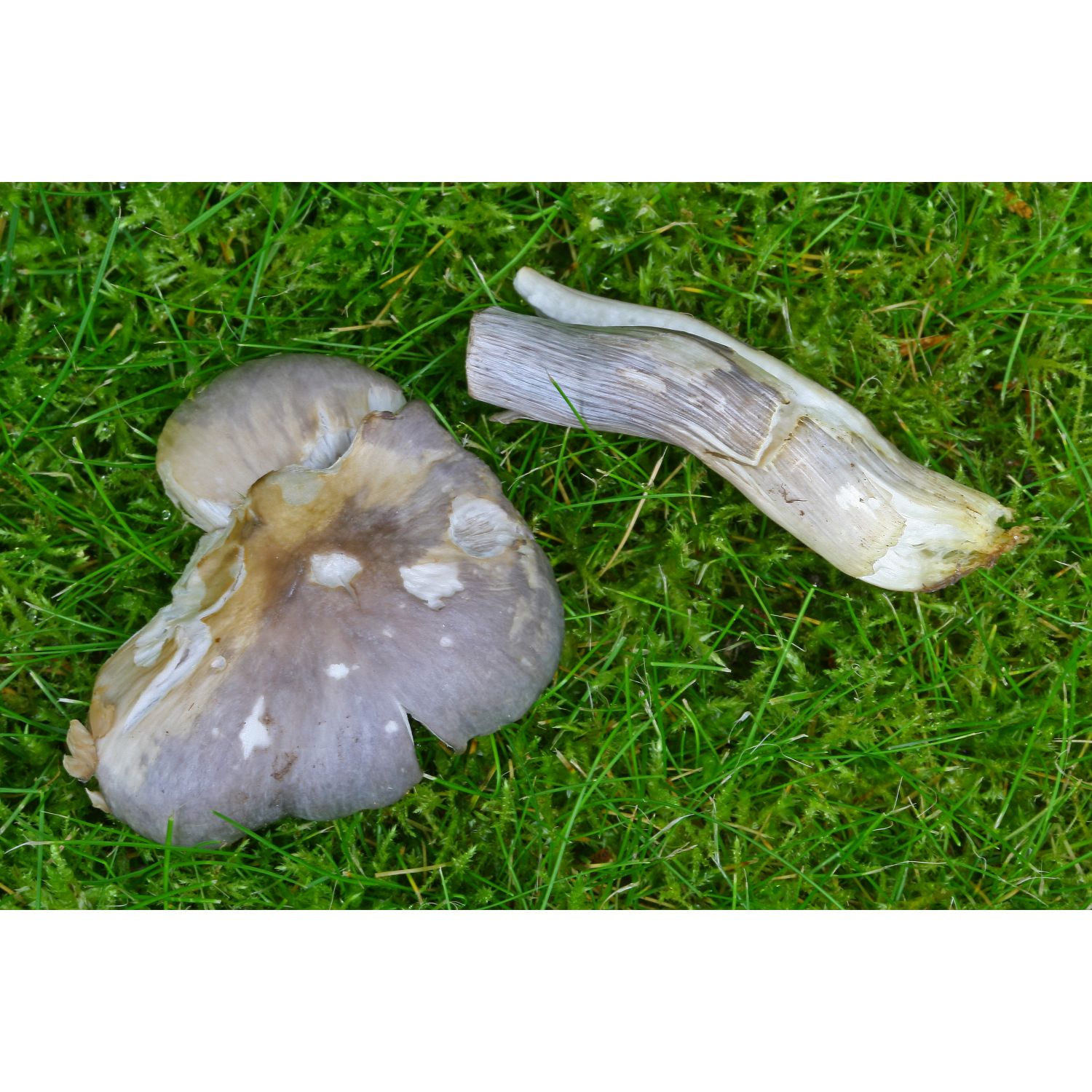 |
Entoloma bloxamii | A stout light lilac to greyish Entoloma and large (7.5-10 micron diam.) spores. Recently epityped with DNA-barcoded material to stabilise the species concept. | Jul-Dec | Confirmed from a number of sites throughout England, and one from Wales. | NA | Yes | 0 | 6 | 5 | 11 | Map |
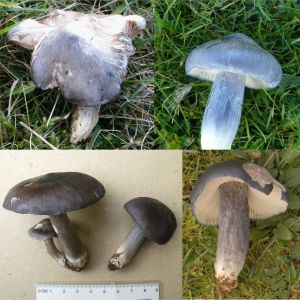 |
Entoloma bloxamii sensu lato | A stout "Big Blue Pinkgill" species concept comprising a number of biological species (E. atromadidum, E. bloxamii s.l., E. madidum and E. ochreoprunuloides f. hyacinthinum). Unresolved historical and recent records can be recorded under this name. | Jul-Dec | Recorded throughout England, Wales, Scotland and Ireland. | 2014 | Yes | 26 | 112 | 18 | 124 | Map |
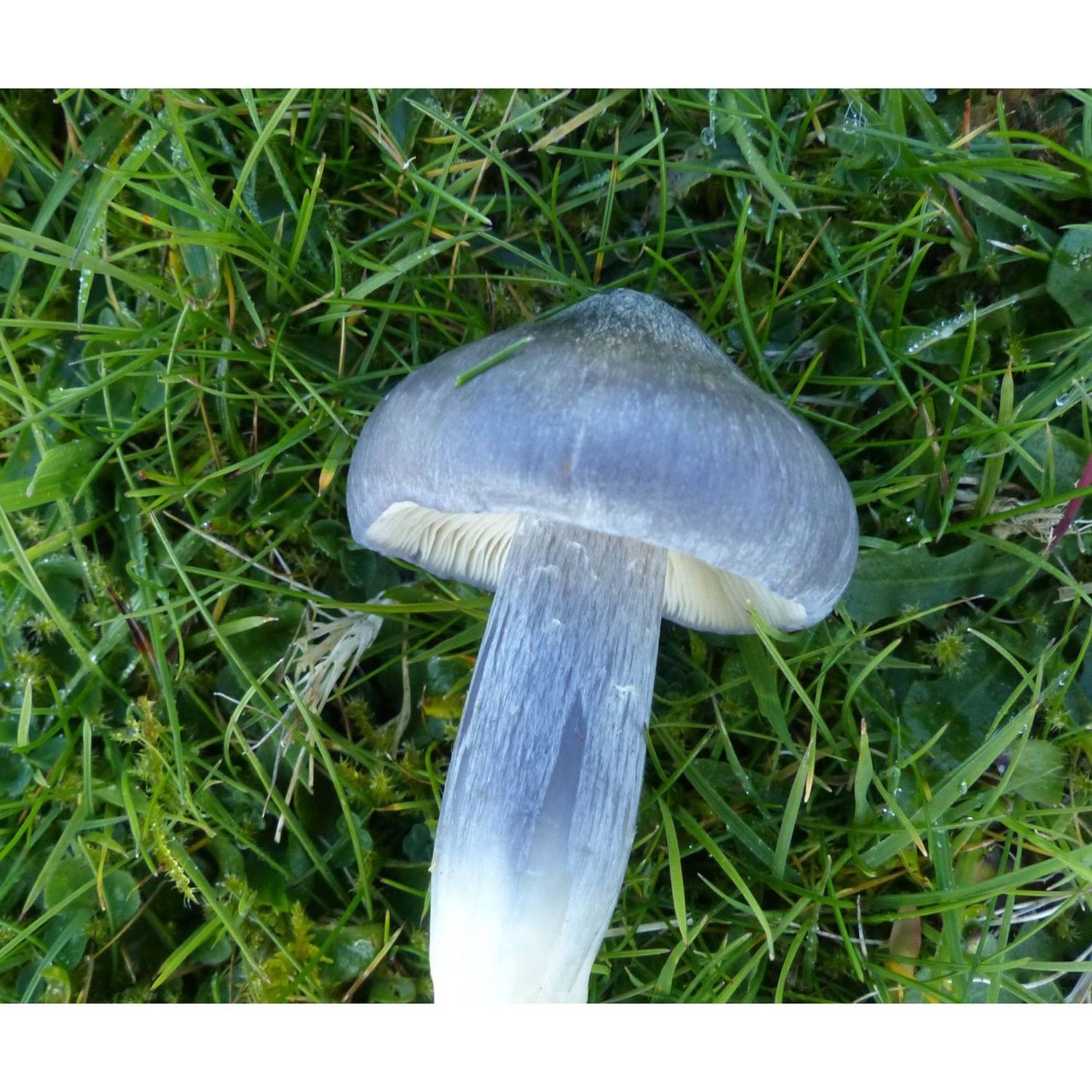 |
Entoloma madidum | A stout bright neon-to-sky blue (fading to light grey) Entoloma with smaller spores (less than 7.5 microns) than E. bloxamii s.s. Recently neotyped to stabilise the species concept. | Jul-Dec | Confirmed from a number of sites in England, Wales, Scotland and Ireland. | NA | Yes | 0 | 10 | 3 | 13 | Map |
 |
Entoloma ochreoprunuloides and E. ochreoprunuloides f. hyacinthinum | A stout Entoloma with a variety of different colour forms, including pinkish, brownish, and brownish with violet tones (the latter being forma hyacinthinum). E. ochreoprunuloides f. hyacinthinum has historically been confused with E. bloxamii and recorded under this name. It usually has smaller spores (less than 7.5 microns) than E. bloxamii s.s. | Jul-Dec | Confirmed from a number of sites in England and Wales. | 2011 (described 2013) | Yes | 0 | 4 | 2 | 6 | Map |
 |
Favolaschia calocera | An unmistakeable small bracket fungus growing on rotten wood. | Sept-Dec | Found in a number of sites in Cornwall and S Devon, further localities within this area to be confirmed. | 2014 | Yes | 0 | 1 | 11 | 11 | Map |
 |
Geastrum marginatum | A small earthstar found on sandy soil in coastal dunes, also recorded as Geastrum minimum (a dubious and ambiguous name globally). | Sept-Nov | Currently known from Norfolk and two sites in Cumbria. | 2013 | Yes | 1 | 5 | 7 | 10 | Map |
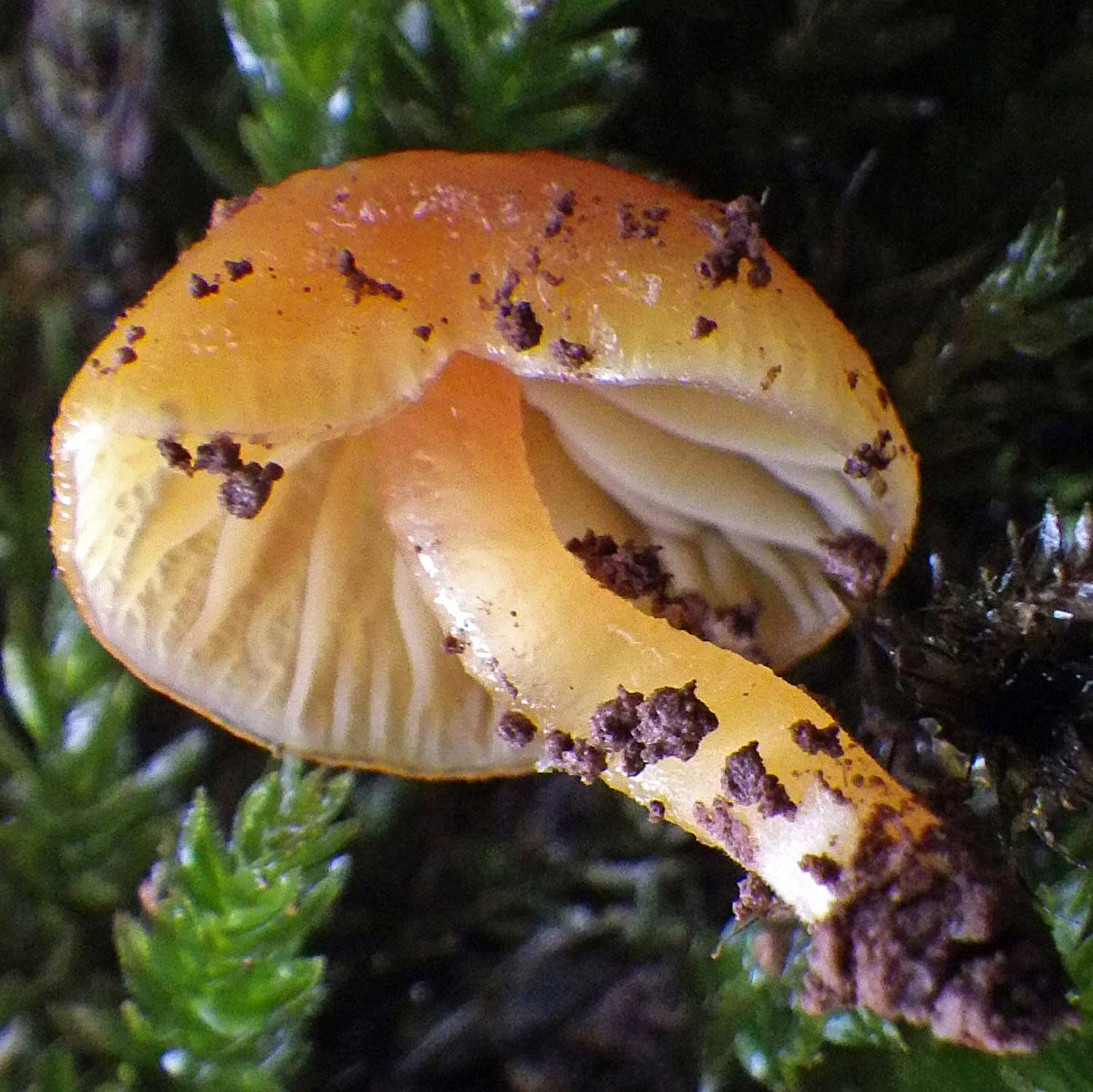 |
Gliophorus europerplexus | A reddish brown waxcap from unimproved grassland and mossy soil. Potentially endemic to Wales. | Sept-Nov | Only known from two sites, in Pembrokeshire and Merioneth. Possibly previously recorded as G. perplexus (=Hygrocybe psittacina var. perplexa), although a further undescribed species is also known to be present in GB&I. | 2013 | Yes | 0 | 7 | 2 | 9 | Map |
 |
Gliophorus reginae | A pink- to purple-capped waxcap mushroom from unimproved grassland. | Oct-Jan | Recorded from scattered localities in south, central and NW England, west Wales and Northern Ireland. | 2013 | Yes | 0 | 9 | 10 | 16 | Map |
|
|
Hericium coralloides | A fungus with a white, branched, coral-like fruitbody of up to 25 cm diam., on fallen trunks and logs of Fagus sylvatica (common beech) and Fraxinus excelsior (common ash). | Aug-Dec, occasionally also Jan-Feb. | Widespread but infrequently recorded throughout south and east England, with occasional records as north as Yorkshire. A single record from Wales (in Monmouthshire VC35). | 2015 | Yes | |||||
 |
Hericium erinaceus | A fungus with distinctive white football-sized fruitbodies, formed of downward-pointing spines 10-40 mm long, fruiting high up on exposed central deadwood of old standing Fagus or Quercus trees. | Sept-Nov, with occasional records from earlier and later months. | Widespread but infrequently recorded throughout south England, with occasional records as north as Cumbria; and in Denbeighshire and Monmouthshire in Wales. | 2015 | Yes | |||||
 |
Hohenbuehelia bonii | An almost sessile (barely stalked), yellow-brown oyster mushroom growing at the base of Ammophila arenaria (marram grass). | Sept-Jan | Found in England (West Sussex and East Kent), Wales (Carmarthenshire, Pembrokeshire and Merionethshire), Scotland (East Lothian) and Ireland (Dublin). | 2012 | Described as a new species as a result of project actions | 0 | 6 | 0 | 6 | Map |
 |
Hohenbuehelia culmicola | A small dark greyish brown to black oyster mushroom, with a well-developed stem fruiting on sand dunes near the base of Ammophila arenaria (marram grass). | Sept-Feb | Found in England (West Norfolk, North-east Yorkshire and Durham) Wales (Glamorgan and Carmarthenshire) Scotland (East Lothian) and Ireland (Dublin). | 2008 | 0 | 7 | 0 | 7 | Map | |
| Hygrocybe roseascens | A grey waxcap with a pink tinge, found in upland pasture and hawthorn (Crataegus) scrub. | Sept-Oct | Recorded twice from a single site in Wales (Caernarvonshire). | 2011 | 0 | 1 | 0 | 1 | Map | ||
 |
Hygrocybe spadicea | A brown waxcap with yellow gills, growing on unimproved grassland, often in well drained south facing situations on lime rich soil. | Jun-Nov | Scattered in England, Wales and Southern Scotland, more frequent in the west. | 2010 | Yes | 4 | 44 | 1 | 44 | Map |
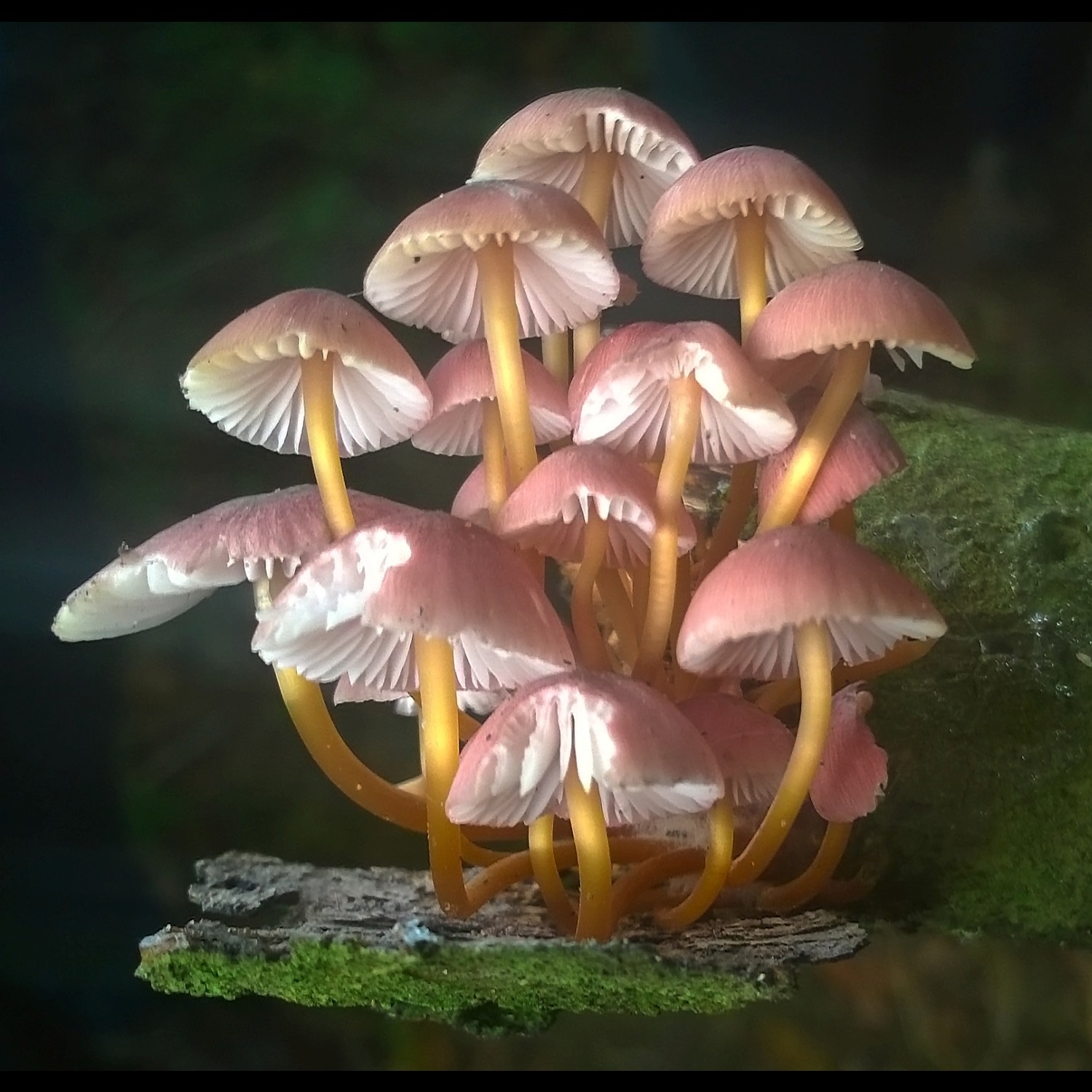 |
Mycena renati | A reddish to pinkish-brown gilled fungus with a yellow stem, growing in groups or clusters on the dead wood of broadleaved trees. | Jun-Oct | Only recorded from England. Recent records are from West Sussex and Lincolnshire. | 2002 | Yes | 5 | 5 | 3 | 7 | Map |
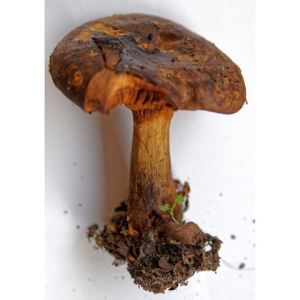 |
Paxillus cuprinus | A light brown to dark coppery-brown gilled fungus found in open sunny places with birch (Betula) alder (Alnus) and hazel (Corylus). | Aug-Nov (also May, possibly May-Nov) | Currently only recorded in the UK in England (N E Yorkshire, Surrey and Middlesex) but likely to be widespread. | 2014 | Yes | 0 | 1 | 17 | 18 | Map |
|
|
Perenniporia ochroleuca | A small bracket fungus on branches of dead wood of mainly on blackthorn (Prunus spinosa) but also hawthorn (Crataegus monogyna), and other hosts, in coastal areas. Distinctive due to its very distinctive, fine and regular pores. | Jan-Dec | Throughout Cornwall, along the south coast of England, Pembrokeshire, and the Channel Islands. | 2014 | Yes | 0 | 24 | 42 | 58 | Map |
 |
Podoscypha multizonata | A fungus forming distinctive brown to reddish rosettes, usually near the base of beech or oak trees in parkland or woodland. | July-Nov | England where it is widespread but infrequently recorded, with only two records from Wales and a single historical record from Scotland. Of conservation concern because England hosts a large proportion of the global population. | 2014 | Yes | 17 | 68 | 26 | 72 | Map |
 |
Postia guttulata | A white bracket fungus exuding drops of liquid when young, found on the wood of conifers including spruce (Picea) and cedar (Cedrus). | Jul-Nov | Recorded from England (Shropshire, Herefordshire, S Hampshire Surrey and E Sussex). | 2013 | Yes | 1 | 5 | 11 | 14 | Map |
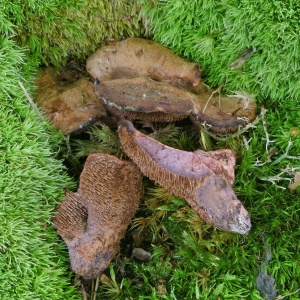 |
Sarcodon joeides | An ochre brown to reddish beige toothed fungus, in moss and leaf litter on lime rich soil with sweet chestnut (Castanea sativa) beech (Fagus) and oak (Quercus). | Sept | Known from single sites in Berkshire, West Kent, and South Devon. | 2010 | Yes | 0 | 1 | 2 | 3 | Map |
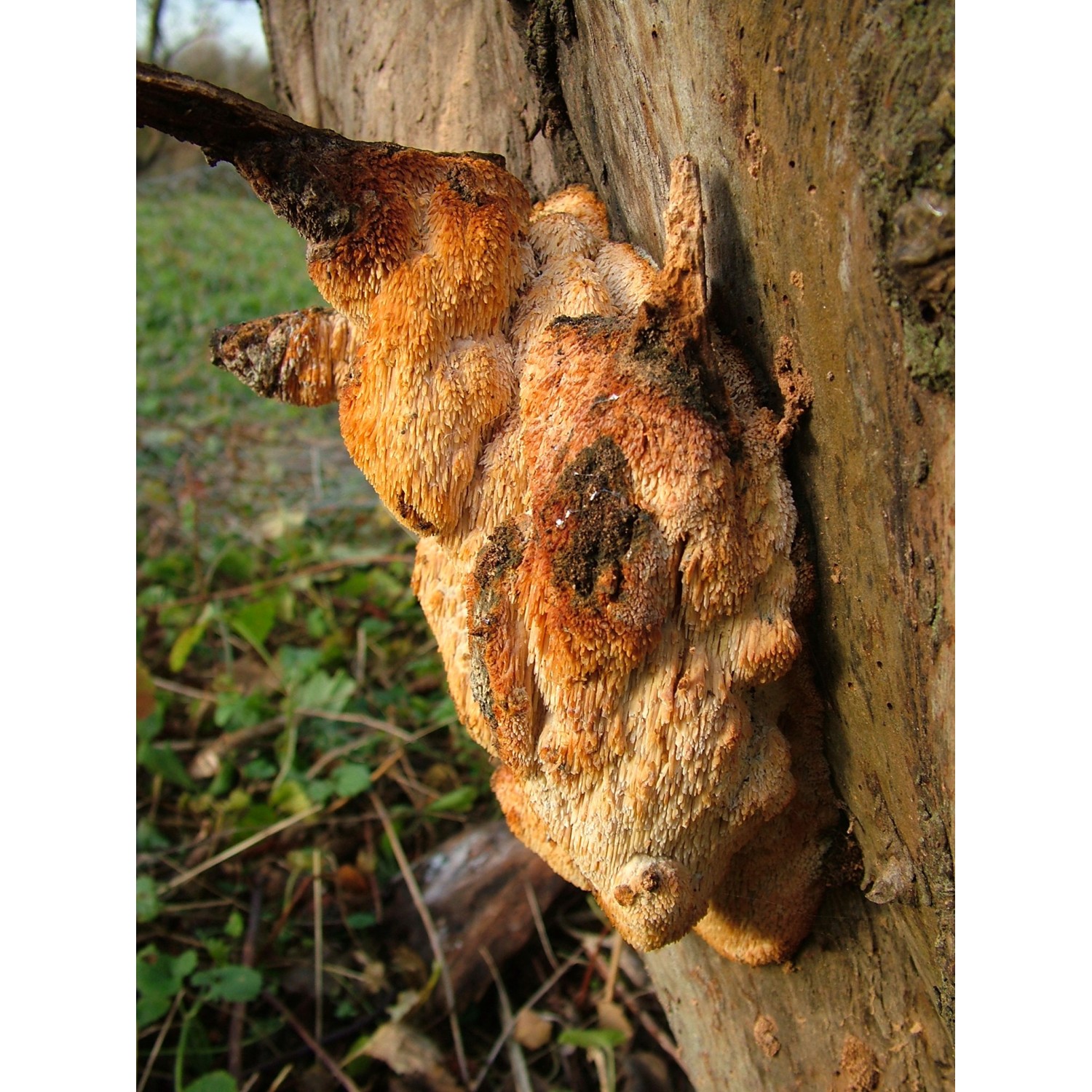 |
Sarcodontia crocea | A yellowish resupinate tooth fungus found on mature fruit trees, mostly on apple (Malus) but sometimes pear (Pyrus) and Prunus species. | Jul-Nov, also Feb. | Throughout England, more frequent in the South East, with a single site in Scotland. | 2013 | Yes | 10 | 22 | 10 | 32 | Map |
 |
PDF - Species Datasheet |
A minute stalked puffball in moss patches on top of limestone boulders | Apr-Dec | Only known from the Inchnadampf area (W Sutherland) (two main sites and three more distant sites from single records); a widespread population at Craig Leek SSSI in S Aberdeenshire; and a new site in Lismore, Argyll. | 2013 | Yes | 0 | 7 | 3 | 8 | Map |
| Xerocomus silwoodensis | A boletoid fungus with a reddish brown cap and red reticulation on the stem, in damp shaded areas with poplar and aspen (Populus) trees. | Jun-Oct | England (Hertfordshire, Berkshire, Hampshire) | 2010 | 0 | 3 | 0 | 3 | Map | ||
Rusts, Smuts and Allies
| Species (links to species information) | Associated organisms/substrata | When to look | Localities | Last recorded (pre project) | Successful search (during project lifespan) | British sites | Maps | ||||
| Pre-1965 | 1965-June 2014 | July 2014-present (LAFF) | Extant (since 1965) | ||||||||
| Exobasidium expansum | A systemic parasite and pathogen of leaves and shoots of Vaccinium uliginosum (bog bilberry), affecting whole shoots and stems, causing leaves to become slightly stunted or enlarged, mottled pale green to reddish above, and eventually developing a chalk-white hymenium below. | July-Sept | Known in GB from only four records, all in Scotland. The two known sites are Coire Cas, near Cairngorm Mountain, East Inverness-shire (recorded 1994); and one in Glen Shee, East Perthshire (recorded 1976). A further two records are poorly localised but probably from near Cairngorm Mountain (recorded 1961 and 1974). | 1994 | 1 | 5 | 0 | 5 | Map | ||
 |
Exobasidium pachysporum | A parasite and pathogen of leaves of Vaccinium uliginosum (bog bilberry), causing discrete pink to wine-red leaf spots. | Aug-Sept | Known in GB from only five sites, one in Cumberland, England (recorded 2008); one West Inverness-shire (recorded 2010), and three East Inverness-shire, Scotland (recorded 2013 and 2015). | 2013 | Yes | 0 | 5 | 2 | 6 | Map |
 |
Puccinia cicutae | A rust on leaves of Cicuta virosa (cowbane). | Jun-Oct | Historically known only from the Fens in East Norfolk, and not recorded between 1956 and 2011. Recently recorded at one site in East Norfolk (2011), and one in East Suffolk (2012). | 2012 | Yes | 7 | 5 | 2 | 6 | Map |
 |
Puccinia cladii | A rust found on living leaves of Cladium mariscus (great fen-sedge). Considered to be rare by Wilson & Henderson. | Mar-Sept | Historical records from E Norfolk, but currently only known from one site in E Norfolk and one in Glamorgan, Wales. Recent surveys of the host in Wales have not found additional sites. | 1958 | Yes | 8 | 5 | 14 | 18 | Map |
 |
Pucciniastrum goodyerae | A rust on leaves of the orchid Goodyera repens (creeping lady's-tresses). | Apr-Nov |
Historically known from Scotland, from Angus, Banffshire, East Inverness-shire, East Ross & Cromarty, East Sutherland, Lanarkshire, and Moray. Only a few populations have been recently recorded, from East Inverness-shire, East Sutherland, and Fife. |
1990 | Yes | 9 | 7 | 5 | 12 | Map |
 |
Urocystis primulicola | An ovary smut on Primula farinosa (bird's eye primrose). | Jul-Sept | Historically recorded only three times, in Cheshire, Durham, Mid-west Yorkshire. Recent records from Durham, Mid-west Yorkshire, West Lancashire, and Westmorland. | 2012 | Yes | 3 | 7 | 2 | 9 | Map |
 |
Uromyces gentianae | A rust on leaves of Gentianella amarella (autumn gentian). | Jul-Sept | Historically recorded from single sites in North Devon, Dorset, South Hampshire, East Kent, and Worcester, with one record from West Suffolk in 1978. Recent surveys have found extant populations in North Devon, North Hampshire, West Sussex, and Bedfordshire. | 2012 | Yes | 6 | 5 | 6 | 8 | Map |
 |
Ustanciosporium gigantosporum
PDF - Species Datasheet |
An ovary smut of Rhynchospora alba (white beak-sedge). | Aug-Nov | Recent records from Dorset and Sutherland, but potentially much more widespread | 1865 | Yes | 2 | 1 | 1 | 2 | Map |
| Map of Top 100 Target species potentially fruiting in September |
|---|
